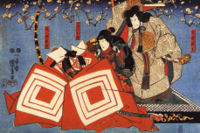
Kumadori
Encyclopedia

Kabuki
is classical Japanese dance-drama. Kabuki theatre is known for the stylization of its drama and for the elaborate make-up worn by some of its performers.The individual kanji characters, from left to right, mean sing , dance , and skill...
actors, particularly when performing in the bold and bombastic aragoto
Aragoto
, or rough style, is a style of kabuki acting that uses exaggerated, dynamic kata and speech. Often, aragoto actors wear bold red or blue makeup , and have costumes that are padded and enlarged...
style. Kumadori makeup generally consists of brightly-colored stripes or patterns over a white foundation, the colors and patterns symbolizing aspects of the actor's character. Though kumadori was originated and developed extensively by members of the Ichikawa Danjūrō
Ichikawa Danjuro
is a stage name taken on by a series of Kabuki actors of the Ichikawa family. Most of these were blood relatives, though some were adopted into the family. It is a famous and important name, and receiving it is an honor...
line of actors, some conventions are creations of the Onoe Kikugorō line.
- Bright red stripes indicate a powerful hero role. The most famous of these roles, and the one which has come to stereotypically represent kabuki in the West, is the hero of ShibarakuShibarakuShibaraku is among the most popular pieces in the Kabuki repertoire, and one of the celebrated Kabuki Jūhachiban . The flamboyantly dramatic costume and makeup used in this scene is famous and widely associated by the average Westerner with Kabuki in general...
. Red symbolizes virtue and power.
- Villains are often depicted with a design of black beard, purple veins, and dark blue antler-like eyebrows.
- Blue makeup can represent a ghost, spirit, or other magical creature, depending on the patterns. KitsuneKitsuneis the Japanese word for fox. Foxes are a common subject of Japanese folklore; in English, kitsune refers to them in this context. Stories depict them as intelligent beings and as possessing magical abilities that increase with their age and wisdom. Foremost among these is the ability to assume...
such as GenkurōGenkuroGenkurō is a shape-changing kitsune character who features prominently in the famous jōruri and kabuki play Yoshitsune Senbon Zakura ....
in Yoshitsune Senbon ZakuraYoshitsune Senbon ZakuraYoshitsune Senbon Zakura , or Yoshitsune and the Thousand Cherry Trees, is a Japanese play, one of the three most popular and famous in the Kabuki repertoire...
wear blue makeup. Blue represents negative emotions such as jealousy or fear; ghosts in traditional Japanese drama are often trapped by their attachment to such emotions.
- Greys and browns can be used sometimes, particularly when representing animals, oni (demons), yōkaiYōkaiare a class of supernatural monsters in Japanese folklore. The word yōkai is made up of the kanji for "otherworldly" and "weird". Yōkai range eclectically from the malevolent to the mischievous, or occasionally bring good fortune to those who encounter them...
(monsters), or anything else inhuman. One example is the tsuchigumoTsuchigumoThe , also called , were a people of ancient Japan, believed to have lived in the Japanese Alps until at least the Asuka period. The name means "ground spider", likely due to perceived physical traits that were later exaggerated or embellished....
(ground spider) fought by Minamoto no Raikō.
The term also applies to a painting method in which two brushes are used simultaneously, one for the color and the other used to create shading or other details.

